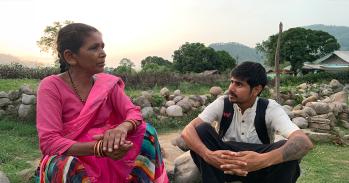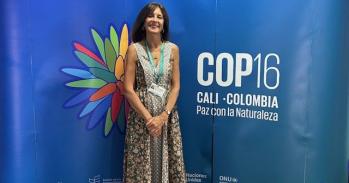Dr Amanda Vincent – one of the world’s leading experts on seahorses and their relatives – is spending a year at Cambridge’s Department of Geography on a sabbatical from the University of British Columbia. She is introducing some new ideas into conservation discussion groups at Cambridge.
Dr Amanda Vincent – one of the world’s leading experts on seahorses and their relatives – is spending a year at Cambridge’s Department of Geography on a sabbatical from the University of British Columbia. She is introducing some new ideas into conservation discussion groups at Cambridge.
Seahorses capture the public imagination in a way that other fish just don’t – in fact many people don’t even think of them as fish at all - and they make a brilliant flagship for marine life.
Dr Amanda Vincent
Pick up a pen and draw a small circle. Then draw another circle round it, and then another. Carry on till you have at least eight circles. Now draw a tiny seahorse in the centre of the smallest circle. What you have drawn is a beautifully simple concept that takes the seahorse – an enchanting and vulnerable creature of which there are dozens of different species - as a starting point for the highly complex interconnectivity of animals, people and policy.
Dr Amanda Vincent, a leading marine biologist and conservation activist, calls this concept ‘the onion world’. “The innermost ring represents the quirky seahorse and its survival, the next ring is its habitat and environment in the shallow seas around the world’s coasts. To ensure the safety and sustainability of that environment, you need to pay attention to the needs of people who depend on the ocean; they constitute the next ring. In turn, they can only make wise decisions if their families are well-cared for and their children are in school,” she explained.
“Then we need law and order, which is the responsibility of government. Indeed the various layers of government, and the rules and regulations they set, are critical circles in this concept. Finally you hit global policy and its growing influence on our conservation story. The outermost layer is essential human influences such as altruism or greed as the most powerful factors of all.”
She continued: “It’s only by working at all these levels simultaneously and in partnership with the fishers, managers and traders that you have a chance of getting it right. It’s inn the process of working in this way that you develop new ideas and approaches. It’s a huge challenge but it’s one we should all embrace. Clearly, this onion world is a mindset and not a skill set, so the scheme also leads us to collaborate with very different thinkers, from school children to religious leaders.”
Currently on sabbatical from the Fisheries Centre at the University of British Columbia, where she holds the Canada Research Chair in Marine Conservation and directs Project Seahorse, Vincent is spending a year at Cambridge’s Department of Geography. She is also participating in Cambridge’s MPhil programme in Conservations Leadership – a ground-breaking course that draws not just on the expertise of the University but also on the expertise embedded in the cluster of organisations based close to the University. Her contribution to the programme, now in its second year, is to raise awareness of marine issues and to impart some of her can-do attitude to the next generation of conservation scientists who have come from all over the world to develop the skills needed to make them leaders.
The ocean represents 99 per cent of the space on Earth where life is possible and supports nearly half of its species. The ocean also represents a hugely important source of nutrition, services and revenue for millions of people. Most people think of the ocean as providing food but they also give us ingredients found in toothpaste, cosmetics and lubricants, to mention just a few.
Similarly, there is a perception of fishers being exclusively male. Research is revealing that many women, especially women in poor communities, fish in order to provide for their families and earn income. Vincent and her students are discovering how marine conservation is affecting women and vice versa. She said: “It stuns me that we are managing the world’s fisheries with so little understanding of what women take from the seas. Our research is showing that women catch almost as much as men in some places, but they do so in a way that’s invisible to the outside world.”
Vincent is not a newcomer to Cambridge. In the late 1980s she did a PhD in the University’s Department of Zoology under Professor Timothy Clutton-Brock, one of the best-known behavioural ecologists. Like all of Clutton-Brock’s students, she was keen to understand the evolution of sex differences. While his other students focused on large mammals, Vincent worked on the quirky seahorse. Her background was far from conventional: she’d spent a good chunk of her childhood travelling around Latin America and, after graduating from university in Canada, she spent three years working her way round the world. She bar-tended in Ireland, picked grapes in France, sheared sheep in Australia, and cycled from Israel to England. These experiences greatly expanded her understanding of people and their different ways of seeing the world.
At Cambridge, Vincent rapidly became an expert on the seahorse and its extraordinary lifecycle. After a three-day courtship, the female seahorse deposits her eggs in the pouch of the male seahorse where he fertilises them and then nourishes them until they are ready to emerge, in what amounts to a full male pregnancy. This method of reproduction makes the seahorse unique. One of Vincent’s interests lay in the gendered behaviour of seahorses. By studying them in tanks in the basement of the Zoology Department and among the sea grasses at the bottom of Sydney Harbour, she found that the male, despite his specialised parental care, retained the conventional sex role of greater competitiveness.
Vincent was the first marine biologist to study seahorses underwater, the first to document the extensive trade in these fishes and the first to initiate a programme dedicated to their conservation. Based at the University of British Columbia and the Zoological Society of London, Project Seahorse works on five continents, where it focuses on developing sustainable conservation schemes in partnership with local communities, resource managers and policy decision-makers.
Early on in her studies, Vincent realised the huge potential of the cute-looking seahorses – part of the syngnathid family – as iconic species for the oceans. “Seahorses capture the public imagination in a way that other fish just don’t – in fact many people don’t even think of them as fish at all - and they make a brilliant flagship for marine life. Their odd shape and amazing lifestyle also delight and excite people,” she said.
After Cambridge, Vincent went on to work at Oxford University and McGill University in her native Canada before landing at the University of British Columbia. Her fascination with the 48 (and counting) species of seahorse and their relatives has never wavered – but her agenda as a conservationist and activist has always been broader. She is determined to tackle some of the big issues and for 13 years she has been working in policy-making at an international level in parallel with her scientific research.
There is a substantial trade in seahorses, both live for aquariums and dried for traditional medicines and souvenirs. This trade has led to great declines in seahorse populations in many areas. Indeed, the global International Union for Conservation of Nature (UCN) Red List of Threatened Species – Vincent sits on the international committee – lists all seahorse species as threatened or so little known that that their risk cannot be evaluated. From 2000 to 2004 Vincent chaired the Syngnathid Working Group of the Convention on the International Trade in Endangered Species of Wild Fauna and Fauna (CITES) and she continues to lead the specialist work in this area.
In 2004 Vincent’s Project Seahorse team played the lead role in bringing all seahorses under CITES, such that 175 countries must now prove that their exports do not damage wild populations. This was a breakthrough for the protection of marine fishes of commercial value, and helped to create a whole new option for global fisheries management. It is also an outstanding example of the onion world in action.
This work is licensed under a Creative Commons Licence. If you use this content on your site please link back to this page.





